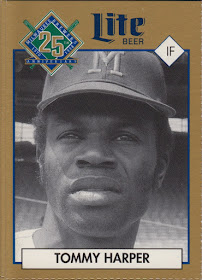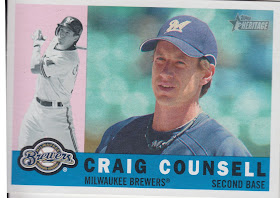It started last week with the return of Aramis Ramirez to the Pirates for what qualifies as a lottery ticket.
#Pirates, #Brewers have now announced trade sending Aramis Ramirez to Pittsburgh. Read more: http://t.co/52bBMot4y2 pic.twitter.com/eiKJlQc1Zf
— MLB Trade Rumors (@mlbtraderumors) July 23, 2015
In that trade, the Brewers received Yhonathan Barrios, a 23-year-old Columbian who started his baseball life as an infielder. He's in Triple-A, has a live arm, but has the typical problem that position players who transition to pitching have -- his fastball is straight and hitters don't really miss it all that much (K/9 in high-A in 2014 was 5.4, Double-A in 2014 and 2015 was 4.2, and Triple-A in 2015 was 5.2). The Brewers assigned him to Double-A Biloxi. Barrios probably is not a prospect -- I mean, how many minor league closers really are prospects? But, the Brewers probably need to find out quickly what he can do since he will be subject to the Rule 5 Draft if the Brewers don't put him on their 40-man roster.
Then, yesterday, there was this drama:
ICYMI: Carlos Gomez said goodbye, Wilmer Flores wept, but there was no #Brewers-Mets trade http://t.co/etOdGFmGKV pic.twitter.com/ZrsUk3hhcl
— Adam McCalvy (@AdamMcCalvy) July 30, 2015
We learned a couple of things yesterday. First, we learned that Terry Collins didn't mind completely embarrassing one of his players during a very emotional time. I don't care if the trade never was consummated. The fact that Flores was that emotional and the fact that Collins did absolutely nothing to help the guy out before pinch hitting for him in the ninth inning shows me that Collins doesn't care about his players.We also learned that the Mets were willing to lie to every news outlet in America when they said that they nixed the trade because of Gomez's adductor and hip muscles. Hell, their reasons kept changing, but the story that seems to have emerged -- and was more plausible than a health issue -- was that the Mets asked the Brewers to pick up part of Gomez's 2016 salary and the Brewers refused. Considering that Gomez is on a team-friendly deal for next year, I can't blame the Brewers for refusing.
Then, tonight, as I sat down to write this post, this happened:
OF Carlos Gomez, RHP Mike Fiers, International Slot 76 to Hou for OF Brett Phillips, OF Domingo Santana, LHP Josh Hader & RHP Adrian Houser.
— Milwaukee Brewers (@Brewers) July 30, 2015
At first, I didn't know what to think, mainly due to my lack of knowledge about the Astros system. Who are these guys?Adrian Houser was the Astros second round pick in 2011 out of high school in Oklahoma. He's a 22-year-old who has not shown much at Double-A this year in the Texas League. He's the one guy who isn't universally on prospect lists, but MLB.com listed him as #21 in the Astros organization as of mid-season.
Josh Hader is now in his third organization in three years. He was drafted by the Orioles in 2011, and the Astros picked him up as part of trading Bud Norris to the O's in 2013. Hader was the Astros Minor League pitcher of the year in 2014 after an excellent year in the California League (and a taste of Double-A) at the age of 20. He's been very good in Double-A in the Texas League this year, and he'll join the rest of the Brewers top prospects in Biloxi (as will Houser and Phillips). MLB.com put him as the 14th best Astros prospect as of mid-season.
Domingo Santana is the most advanced of the four prospects in that he is at Triple-A and will be assigned by Milwaukee to Colorado Springs. In Fresno, he was hitting .320/.426/.582 with 16 HRs, 48 BBs, 91 Ks in 326 plate appearances. It's his second season at Triple-A. He looked terribly overmatched last year when the Astros brought him up for a cup of coffee in September -- as in, 0-for-17 with 14 strikeouts overmatched. This year, in 14 games, he hit .256/.310/.462 in 42 plate appearances (but, again, a lot of Ks and not many BBs -- 2 BB, 17 Ks). Coming in to the season, he was rated as the #71 Prospect in baseball by MLB.com (he dropped to #87 at mid-season), and as of mid-season he was the #7 prospect in Houston's system.
Finally, there is Brett Maverick Phillips. No kidding. That's his name. It should surprise no one to hear that Brett Maverick was born and raised in Seminole, Florida. He was drafted out of high school in the sixth round in 2012 by the Astros, and he was considered untouchable until the Brewers were willing to put Mike Fiers into the deal. He's an outfielder who has been raking at the plate over the past two years -- .310/.375/.529 last year in the Midwest League and California League and .320/.377/.548 in the California League and the Double-A Texas League this year. He was rated as the Astros 2nd best prospect at mid-season behind Alex Bregman and ahead of Mark Appel and as the 39th best prospect overall.
For me, there's a little bit of sadness, of course, in having one of the guys I really tried to collect in Carlos Gomez getting traded. At this point, though, I'm okay with it. I mean, he does have Scott Boras as his agent. So, that means that he would have never re-signed with Milwaukee after his contract expired at the end of next season. He'll be 31 when he starts the season in 2017, so you have to think he'll be looking for a very rich 5- to 7-year deal -- probably with the Yankees or Cardinals just to piss me off.
So, thanks, Carlos, it's been great collecting your cards.
Maybe I should start a Maverick collection.



















































